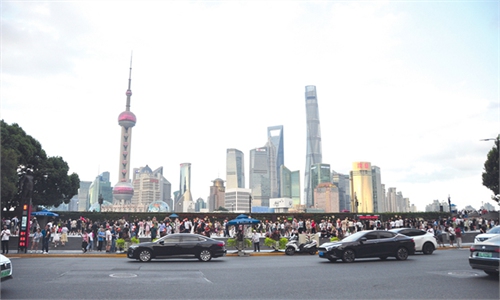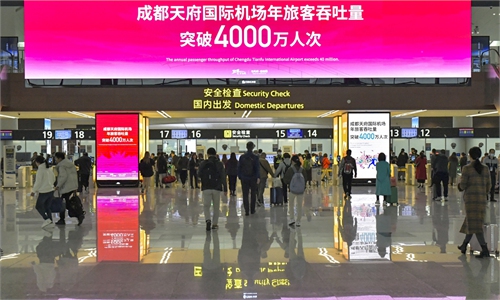China set to embrace consumption boom during New Year holidays, bolstering economic recovery in 2024

A tourist poses for a photo in snow at the Palace Museum in Beijing, capital of China, Dec. 13, 2023. China's meteorological authority on Wednesday renewed a yellow alert for blizzards, forecasting intense snowfall in the north of the country.(Photo: Xinhua)
Embark on a special ice and snow train to Northeast China's Yabuli for skiing, witness the New Year's fireworks at Shanghai Happy Valley, or indulge in a spa retreat at a hot spring hotel in South China's Guangzhou, a dazzling array of Chinese people's New Year itineraries are boosting festival consumption in the world's second-largest economy.
Together with companies, local authorities have been seeking new ways to unleash the consumption potential during the upcoming holiday season; observers noted that the Chinese economy, which remains on an accelerating path to recovery, is set to see further growth in the year ahead.
Tourism remains one of the driving factors in fueling the consumption momentum. Data from major travel platforms is pointing toward a comprehensive recovery for both domestic and cross-border tourism.
Domestic travel platform Mafengwo said in a note sent to the Global Times that topics related to "New Year's trip destination" discussed on the platform have increased by 266 percent over the past week.
As of December 15, overall travel bookings for the New Year's Day holiday had surged more than threefold compared to 2022, with hotel reservations experiencing a remarkable fivefold increase. Airline ticket bookings have seen a remarkable growth of 205 percent year-on-year, according to data sent to the Global Times by the online travel agency Trip.com.
For those travelling domestically, first-tier cities like Beijing and Shanghai, along with the snow-covered Harbin in Northeast China's Heilongjiang Province and temperate South China's island province of Hainan, are among the top destinations for New Year's travel.
Cross-border tourism is also growing on the back of favorable visa policies.
According to forecasts by the National Immigration Administration on Thursday, with the continuous resumption of international (regional) flights, combined with policies such as Thailand and Malaysia granting visa-free entry to Chinese citizens and China unilaterally granting visa-free entry to citizens from six countries including France and Germany, the New Year period is expected to witness a peak in immigration and emigration across the country's ports.
The daily influx and outflow of passengers are projected to reach 1.56 million, five times that of the 2023 New Year holidays and accounting for 90 percent of the figures from the same period in 2019, the administration said.
The tourism boom is driving heightened activity in dining, accommodation and various other retail sectors. As of Wednesday, the pre-bookings for the 2024 New Year holidays, including accommodation, tickets, and transportation, have surged by over 500 percent year-on-year, according to data from Meituan, China's largest food delivery provider, and Dianping, also known as the Chinese equivalent of Yelp.
"Adding a sense of ceremony and ambiance" to New Year's celebrations has surged in popularity and become a consumption trend. Over the past week, the number of dining establishments offering "New Year" themed group packages and the associated order volume on the Meituan platform have witnessed a substantial surge, according to the company.
Moreover, Taxi demand during the New Year holiday is expected to increase by 100 percent compared to 2022, with ride-hailing orders for inter-city trips rising by nearly 220 percent year-on-year, according to a forecast from Didi Chuxing.
The retail boom during the New Year's Day holidays may further extend to the upcoming Spring Festival holidays, the traditional peak season for consumer activity, and will together contribute to a sound and stable recovery for China's economic growth in the new year, Zhang Hong, a Beijing-based macroeconomic observer, told the Global Times on Thursday.
In the first 11 months of the year, China's total retail sales of consumer goods reached 42.8 trillion yuan ($6.03 billion), a year-on-year increase of 7.2 percent. The total value of goods in import and export amounted to 38 trillion yuan, maintaining stability compared to the previous year. China continues to hold its position as the world's second-largest consumer market and the leading country in global goods trade, according to Chinese Ministry of Commerce (MOFCOM).
In the first three quarters of 2023, the contribution rate of final consumption expenditure to economic growth reached 83.2 percent, according to MOFCOM.
A number of stimulus policies from the central government will likely fuel consumption momentum throughout next year.
"We will ensure the supply of the holiday market by guiding regions to increase efforts in organizing the supply of essential goods, strengthening the connection between production and sales, and diversifying product offerings," He Yadong, a MOFCOM spokesperson, told a regular press conference held in Beijing on Thursday.
In the first quarter of next year, MOFCOM's focus will be on promoting domestically produced products, launching a nationwide online New Year Shopping Festival, among other special events to promote consumption. Simultaneously, various regions will innovate and organize diverse activities tailored to local contexts, fostering a vibrant festive consumer atmosphere, He said.



